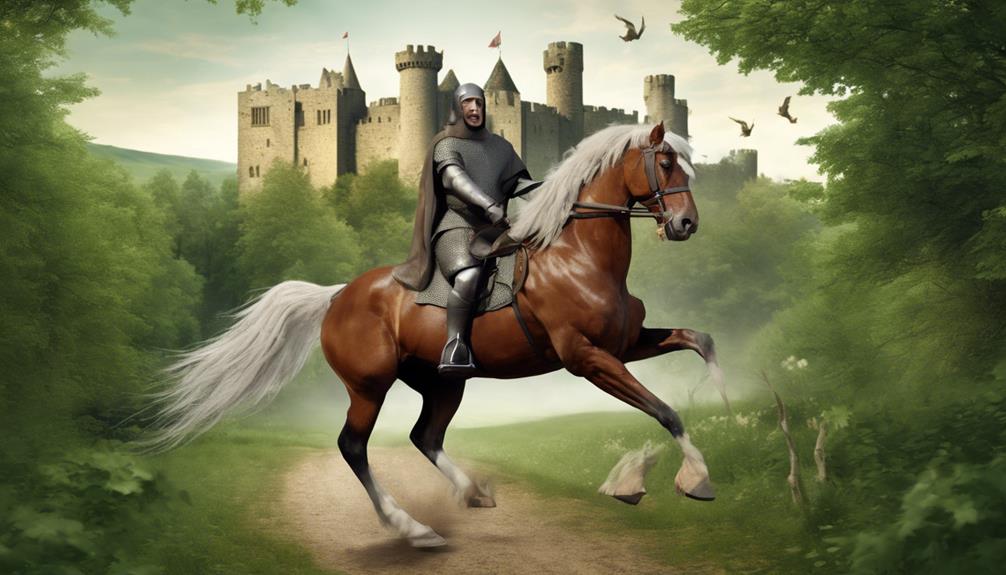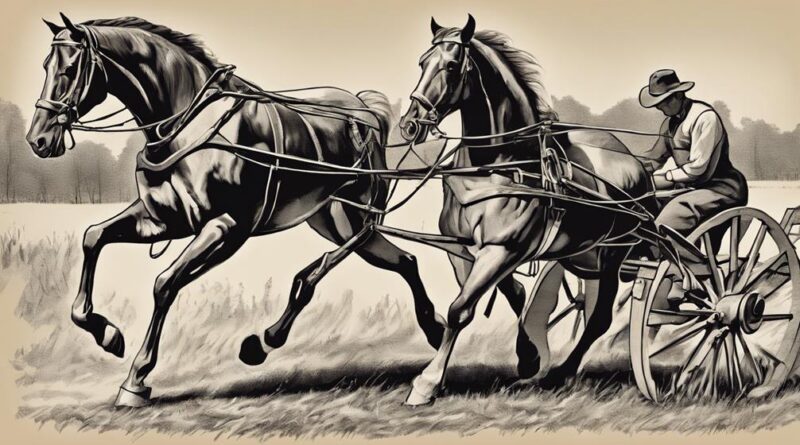Key Uses of Historical Horse Breeds: Top Tips
Have you ever wondered how historical horse breeds shaped civilizations?
From the majestic warhorses that carried knights into battle to the sturdy workhorses that plowed fields, each breed served a unique purpose in history.
But what about their lesser-known roles and the top tips for recognizing these historical horse breeds?
Explore the diverse uses beyond the surface and uncover fascinating insights into the world of equine history.
Understanding their significance may just surprise you and shed light on the intricate tapestry of human-animal partnerships throughout the ages.
Warhorses in Ancient Battles
Warhorses played a crucial role in ancient battles as powerful and resilient companions to warriors. These majestic creatures weren't only symbols of strength and courage but also instrumental in the success of various military campaigns. Training techniques were essential in preparing these warhorses for the chaos of battle. From a young age, they underwent rigorous training to instill discipline, obedience, and the skills needed to navigate the tumult of war.
Battle strategies heavily relied on the capabilities of warhorses. Cavalry units mounted on these magnificent animals could swiftly maneuver across the battlefield, providing strategic advantages such as speed and agility. The thunderous sound of hooves charging towards the enemy could instill fear and disrupt enemy formations, turning the tide of battle in favor of those with well-trained warhorses.
In addition to their brute strength, warhorses were also trained to remain calm in the face of danger, making them reliable assets in the heat of combat. Their unwavering loyalty to their riders forged deep bonds that were crucial for effective communication on the battlefield. These noble creatures weren't merely beasts of burden but esteemed companions who shared in the risks and triumphs of war alongside their human counterparts.
Carriage Horses in Royalty
Carriage horses adorned in regal attire gracefully transported royalty through the streets, embodying elegance and prestige. These majestic animals played a crucial role in royal processions and ceremonial duties, symbolizing power and grandeur.
- Symbol of Status: Carriage horses were a symbol of the monarch's authority and wealth, showcasing the grandeur of the royal family during public events.
- Elegance in Motion: The graceful movements of carriage horses added a touch of sophistication to royal processions, captivating onlookers with their poise and beauty.
- Precision and Training: These horses underwent extensive training to ensure they could navigate crowded streets and maintain composure during elaborate ceremonies.
- Historical Significance: Carriage horses have a rich historical significance, dating back to ancient times when they were an integral part of royal rituals and events.
Whether pulling luxurious carriages during state events or leading royal processions through the city streets, carriage horses weren't just a mode of transportation but an essential element of the regal spectacle. Their contribution added a touch of splendor to ceremonial occasions, leaving a lasting impression on all who witnessed their graceful presence alongside royalty.
Workhorses in Agriculture
Agricultural workhorses have been indispensable partners to farmers for centuries, laboring in fields and pulling heavy loads to support agricultural activities. These sturdy animals have played a crucial role in farming operations, aiding in various tasks such as plowing fields and transporting goods.
When it comes to plowing techniques, workhorses have been utilized to pull plows through fields, breaking up the soil to prepare it for planting. The strength and endurance of workhorses make them ideal for this demanding task, allowing farmers to efficiently cultivate their land.
In terms of crop rotation strategies, workhorses have been instrumental in helping farmers implement sustainable farming practices. By rotating crops in different sections of the field, farmers can improve soil health and reduce the risk of pests and diseases. Workhorses play a key role in this process by assisting in the transportation of crops and materials needed for planting.
Racing Horses for Speed
When it comes to horse racing, speed is the ultimate goal for breeders and trainers alike. Achieving top speeds in horse racing involves a combination of specialized training techniques and strategic breeding strategies. Here are some key points to consider:
- Selective Breeding: Breeders carefully select parent horses with a history of speed and endurance to produce offspring with the desired racing traits.
- Crossbreeding for Speed: Some trainers experiment with crossbreeding different horse breeds known for their speed to create hybrids that excel in racing competitions.
- Interval Training: Trainers often use interval training techniques to enhance a racing horse's speed and stamina. This method involves alternating between high-intensity sprints and periods of rest or slower-paced exercises.
- Nutritional Planning: Proper nutrition is essential for developing a racing horse's muscle strength and overall performance. Trainers work closely with equine nutritionists to create balanced diets tailored to each horse's specific needs.
Cattle Horses in Ranching
To shift focus from racing horses for speed, let's now explore the integral role of cattle horses in ranching. Cattle horses play a crucial part in livestock management on ranches, working alongside cowboys to ensure the smooth operation of cattle herding and other tasks. These horses are known for their strength, agility, and steady temperament, making them well-suited for the demands of ranch work.
Working cowboys rely on cattle horses to help them navigate vast expanses of land, round up cattle, and move them from one pasture to another. The horses' ability to maneuver quickly and effectively in varying terrains is essential for the success of these operations. In addition, the strong bond between the cowboy and their horse is vital for building trust and communication in handling livestock.
Livestock management involves tasks such as sorting cattle, branding, and checking on the health of the herd. Cattle horses aid in these activities by providing the necessary speed and agility to chase down individual animals or swiftly change direction when needed. Their contribution to the efficiency of ranching operations can't be overstated.
Artillery Horses in Warfare
During times of war, artillery horses played a crucial role in transporting heavy cannons and equipment across challenging terrains. These majestic creatures were invaluable assets to the military, supporting the firepower needed on the battlefield.
Here are some key points highlighting the significance of artillery horses in warfare:
- Strength and Endurance: Artillery horses were selected for their immense strength and endurance, capable of pulling heavy cannons over long distances without tiring easily.
- Mobility and Speed: Unlike stationary artillery units, artillery horses provided the mobility and speed required to reposition quickly on the battlefield, allowing for more strategic maneuvers.
- Protection and Support: These horses not only transported artillery but also provided a level of protection and support for the crews operating the cannons, enabling smoother operations under fire.
- Integration with Cavalry: Artillery horses often worked in conjunction with cavalry horses and other military steeds, creating a cohesive unit that could respond effectively to dynamic combat situations.
The role of artillery horses in warfare highlights the importance of well-trained and reliable animals in military operations. Their contribution to the success of artillery units can't be understated, showcasing the deep historical connection between horses and the art of war.
Messenger Horses in Communication

Pivoting from the discussion of artillery horses in warfare, the critical role of messenger horses in communication can't be overlooked. These equine messengers were vital for delivering messages swiftly and efficiently, especially during times when communication needed to be discreet or when traditional methods weren't feasible.
One significant example of messenger horses in communication is the Pony Express, a revolutionary mail service in the mid-1800s in the United States. Riders on specially trained horses carried mail across vast distances, ensuring quick delivery between the East and West Coasts. The Pony Express shortened the time it took for messages to travel, playing a crucial role in connecting the expanding nation.
Courier horses were also commonly used by various postal services worldwide for message delivery. These horses were trained to cover long distances at high speeds, allowing important correspondence to reach its destination promptly. Their reliability and speed made them indispensable in ensuring that messages were transmitted efficiently.
Exploration Horses in Discoveries
Explorers relied heavily on the endurance and agility of their trusty steeds to navigate uncharted territories and make groundbreaking discoveries. These exploration companions played a vital role in the success of expeditions, carrying their riders through diverse landscapes and challenging conditions.
- Versatility: Exploration horses needed to adapt to various terrains, from rugged mountains to dense forests, showcasing their versatility in different environments.
- Reliability: These horses weren't just animals; they became reliable partners to their riders, fostering a deep bond built on trust and mutual understanding.
- Speed and Efficiency: With their speed and agility, exploration horses enabled expeditions to cover vast distances efficiently, making it possible to explore new lands within a reasonable timeframe.
- Cultural Significance: The relationship between explorers and their horses goes beyond practicality. It holds cultural significance, symbolizing the spirit of adventure and the unbreakable bond between humans and animals in the face of the unknown.
In essence, exploration horses were more than mere modes of transportation; they were indispensable companions that contributed to the success of groundbreaking discoveries while embodying the essence of exploration and the enduring partnership between humans and animals.
Frequently Asked Questions
Can Historical Horse Breeds Still Be Found in Modern Agriculture Practices?
Yes, historical horse breeds can still be found in modern agriculture practices. Through equine genetics and breeding practices, these breeds are valued for their unique characteristics that contribute to modern farming and sustainability.
How Have Historical Horse Breeds Influenced the Development of Modern Horse Breeds?
Historical horse breeds have significantly impacted the development of modern horse breeds. Genetic influences from these ancient breeds have shaped the characteristics and traits we see in horses today.
Breeding techniques honed over generations have allowed for the refinement and enhancement of desirable traits, resulting in the diverse range of horse breeds we've today. Through careful selection and breeding practices, historical horse breeds have left a lasting legacy in the evolution of modern horse breeds.
What Are Some Lesser-Known Historical Horse Breeds That Were Used for Specific Purposes?
When looking into lesser-known historical horse breeds, you'll discover fascinating stories about their unique characteristics and sporting abilities. These breeds not only contribute to genetic diversity but also inspire conservation efforts.
Exploring these hidden gems sheds light on the diverse roles horses have played throughout history, showcasing their significance beyond the well-known breeds.
Take the time to delve into these hidden treasures for a deeper appreciation of the equine world.
Are There Any Cultural or Symbolic Meanings Associated With Specific Historical Horse Breeds?
When thinking about historical horse breeds, you might wonder about their cultural or symbolic meanings. Different horse breeds have held significant symbolic significance in various cultures throughout history.
For example, the Arabian horse is often associated with nobility and grace in many cultural traditions. Understanding these meanings can deepen your appreciation for the unique roles that historical horse breeds have played in shaping different societies.
How Have Advancements in Technology Impacted the Role of Historical Horse Breeds in Various Industries Over Time?
Technology has significantly influenced the role of historical horse breeds in various industries. Advancements in breeding practices have improved horse characteristics for specific tasks. This has led to increased efficiency and effectiveness in sectors like agriculture and transportation.
Economically, these developments have boosted productivity and profitability. Historical horse breeds continue to hold a significant place due to their adaptability and historical significance.
Conclusion
Overall, historical horse breeds have played crucial roles throughout history. They have served as warhorses in ancient battles, carriage horses for royalty, workhorses in agriculture, racing horses for speed, cattle horses in ranching, artillery horses in warfare, messenger horses in communication, and exploration horses in discoveries.
These versatile animals have been essential partners in various aspects of human civilization. They showcase their strength, speed, and intelligence in a wide range of important tasks.
